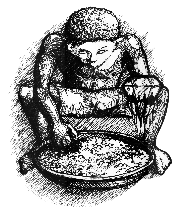|
Movie Review
|
|
Is a Blood Diamond Forever?
Printable Version: Download
as PDF
Hollywood can't seem to get enough of Africa. Academy-award nominated Blood Diamond is just one of the recent blockbusters set in a war-torn African country (think "Hotel Rwanda" or "The Last King of Scotland"). Starring Leonardo DiCaprio as a Zimbabwean diamond smuggler, Blood Diamond examines the tangled relationship between the illegal diamond industry and Sierra Leone's decade-long civil war. Sierra Leone's civil war ended in 2002, the same year the United Nations established the Kimberley Process Certification Scheme (KPCS). The KPCS is a self-enforced system that inhibits "conflict diamonds" from entering the market. To be considered "conflict-free," a diamond may not be mined in a war zone or sold to finance a rebel army. But the KPCS does not place any restrictions on diamonds mined in inhumane working conditions. Diamond miners in Sierra Leone today make an average of less than $1 a day, placing them in the category of desolate poverty. Unfortunately, Web sites like diamondfacts.org declare that more than 99 percent of diamonds sold today are "conflict-free," perpetuating the misconception that habitual traditions like buying diamond is ethical. Miners' working conditions are therefore not publicized. In addition to concealing inhumane working conditions, the diamond industry has always publicized diamonds as a rare gem. This common belief, however, is false. DeBeers Diamond Mining Company founder Cecil John Rhodes monopolized the international diamond trade, on the deceptive premise that diamonds were precious and unavailable. Rhodes was also successful in marketing engagement diamonds as a necessary tradition, which is really a form of cultural violence. Cultural violence is the process by which demonizing and polarizing ideologies are propagated to prepare people to participate in direct violence (physical harm) or structural violence (systems of oppression such as economic exploitation). Cultural violence includes nationalism, militarism, and materialism, and can be manifested in such innocuous forms as songs, flags and advertisements. One example of cultural violence is the tradition of buying a diamond engagement ring. All over the world, people buy diamond engagement rings without considering the direct or structural violence that results in the diamond's country of origin. Environmental degradation is another example of overlooked effects of the diamond industry. The diamond mining in Sierra Leone is extremely detrimental to the land, leaving it unsuitable for farming. In addition, mining on hilly areas may result in severe erosion, crippling an already fragile ecosystem. Water collecting in already-mined areas accumulates into ponds, providing a breeding ground for mosquitoes, which increases risks of malaria and other water-borne diseases. The siltation caused by mining also reduces coral and fish populations. Contaminated marine life is unfit to eat, eliminating a healthy diet option for the two-thirds of Sierra Leoneans living in absolute poverty. Just as opening a soup kitchen will not eradicate hunger, placing voluntary regulations on diamond smuggling does not come close to fully eradicating the harmful effects of diamond mining. The KPCS needs to be seriously restructured so that the legal diamond trade is scrutinized as much as the illegal diamond trade. While Blood Diamond denounces the corrupt entanglement between the diamond trade and Sierra Leone's 1990s civil war, it does not touch upon how the industry has reproduced itself as an elitist enterprise for over a century, or why consumers have not questioned what makes diamond wedding rings a traditional part of our culture. If diamonds cannot be mined in an eco- and people-friendly manner while still economically benefiting poverty-stricken African miners, the entire enterprise - illegal or legal - should have no valid place in our society.
Anna Kallett is a Peace and Conflict Studies major with an emphasis in Human Rights. She enjoys stacking Russian dolls according to size and unraveling wool sweaters. |
||
|


